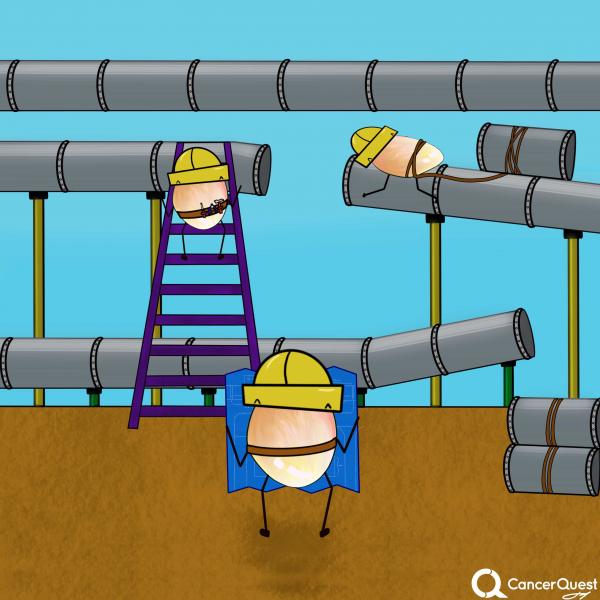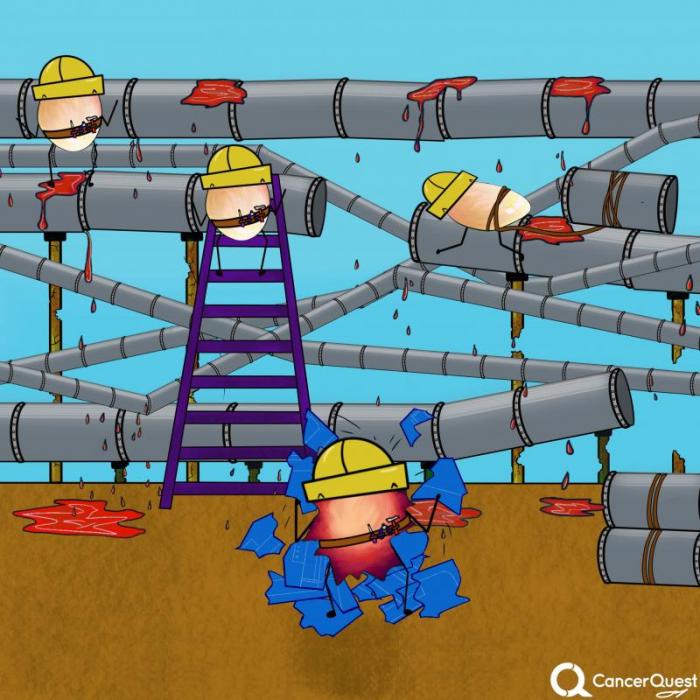All cells need a constant source of oxygen and nutrients such as glucose (sugar). Our cells get their nutrients delivered to them via the blood. Nutrients and oxygen are pumped through the body via the circulatory system. Once in the tissues, the nutrients cross the blood vessel walls and enter the spaces around the cells. Cells need nutrients constantly, and the process by which nutrients float over to cells takes time. In order to make sure that all cells get enough nutrients, our tissues are full of many small blood vessels (capillaries) that can deliver food to within a very short distance of any cell. Further information on the topics on this page can also be found in most introductory Biology textbooks, we recommend Campbell Biology, 11th edition.1
Introduction to Angiogenesis
Even though cancer cells are abnormal, they still require oxygen and nutrients. The development of blood vessels is an essential step in the growth of a tumor. Without vessels tumors cannot grow to be larger than a small fraction of an inch.2, 3, 4, 5, 6 When the area around the cells in a tumor starts to get too far from a blood vessel, the oxygen and nutrient levels start to go down. A decrease in oxygen is also called hypoxia. Hypoxia triggers changes in the behavior of the tumor cells.
The tumor cells produce (or cause nearby cells to produce) growth factors that stimulate the formation of blood vessels. Tumors that do not produce (or cause other cells to produce) angiogenesis factors can not grow.3 One of the most well-studied angiogenesis factors is called vascular endothelial derived growth factor (VEGF). VEGF or other angiogenesis factors produced by tumor cells or nearby cells can cause the development of blood vessels that feed the growing tumor. Because VEGF is a normal signal for the cells forming the blood vessels, they are really just doing their job. The tumor 'tricks' the body into creating new blood vessels. The blood vessels created in this way are not exactly the same as normal blood vessels. Frequently they are less organized and leakier than normal vessels.

Blood vessels provide nutrients and oxygen to cells. They are frequently built and repaired. The process is very organized and efficient. Examples include wound healing and the menstrual cycle.

Tumors need blood vessels to survive, but the blood vessels are abnormal, twisted and leaky. This can lead to treatment resistance and the spread of cancer.
Abnormal angiogenesis is not limited to cancer. Other diseases, including macular degeneration, a progressive eye disease, are linked to abnormal development of blood vessels.5 The process of angiogenesis in cancer is shown in the animation below.
Angiogenesis as a Drug Target
Like all cells, cancer cells require a constant supply of nutrients and oxygen in order to grow and divide. Without an adequate blood supply tumors will not grow. Tumors produce factors that stimulate the formation of blood vessels to provide them with the food and oxygen they need.
The process of blood vessel formation is termed angiogenesis.This process is a very active area of research in cancer treatment for several reasons. 1. The treatments should have low toxicity. Angiogenesis occurs at high levels during fetal development, the menstrual cycle and in wound healing. The treatments might be expected to interfere with these processes but should not harm most normal dividing cells. 2.The treatments are not designed to directly attack the cancer cells. The targets of several of these treatments are normal processes controlled by normal cells (such as the cells that form blood vessels), not the tumor cells themselves. The high mutation rates of cancer cells that often render chemotherapy ineffective will not interfere with these drugs.
Angiostatin
This drug is actually a naturally occuring protein that is derived from the cleavage of a larger protein, plasminogen. Angiostatin inhibits the growth of blood vessels in tumors and has been shown to inhibit metastasis of tumors in animal models. This drug is is no longer in clinical trials7, 8, 9
Endostatin/Endostar
Like angiostatin, this drug is a naturally occuring protein. Endostatin is derived from a form of collagen, a structural protein found in connective tissue. 7, 8
In early trials, endostatin was shown to be safe and exhibit low toxicity. 10, 11, 12, 13 More recently, researchers in China have developed a slightly modified version of endostatin that is more stable, easier to manufacture and more potent14. The drug still works by inhibiting angiogenesis15. The new version, Endostar, is currently in clinical trials - mainly in China.
Search for current clinical trials involving Endostar.
The development and marketing of Endostatin are now being advanced by Alchemgen and Children's Medical Center Corporation
A Closer Look at the First Angiogenesis Inhibitors
The growth of blood vessels into tumors is only half of the story. It was postulated as long ago as 1971 by Dr. Judah Folkman that prevention of angiogenesis could inhibit tumor growth by starving them of vital nutrients.16 The existence of natural inhibitors of angiogenesis was hinted at by an intriguing observation made by surgeons. They found that the surgical removal of a large primary tumor often led to the rapid development of metastatic growths. This observation suggested that the primary tumor was producing something that kept small metastatic growths from progressing. When the large tumor was removed, the smaller tumors were free to grow.
The first naturally occuring inhibitor discovered was thrombospondin, identified in 1989 by Dr. Noel Bouck.17 Two more natural inhibitors were dicovered by Dr. Michael O'Reilly in Dr. Folkman's lab, angiostatin in 1994 and endostatin in 1997.18, 19 Both molecules are small proteins that are derived from larger proteins that, remarkably, have different functions in the body.
As treatments, the first two inhibitors discovered shared two very exciting features: 1) Because they are natural products of the body, they should be much less toxic than conventional chemotherapy drugs. 2) Because they act on normal (blood vessel) cells instead of attacking the tumors directly, they should be much less likely to lead to the selection of drug-resistant tumors.
Angiostatin is no longer being examined as a possible cancer drug. Endostatin, in the form of Endostar® is in clinical trials.
Since blood vessel formation, or the lack of it, is at the root of many human diseases, controlling this process has potential in several disorders in addition to cancer. The story of Judah Folkman's search was the subject of a NOVA special that can be viewed online.
Since this process is key to the growth of tumors, many drugs are currently being investigated for their potential to inhibit angiogenesis and tumor growth and several drugs with antiangiogenesis activity have been approved to treat cancer.
Learn more about angiogenesis inhibitors in the cancer treatment section of the site.
Angiogenesis Summary
Tumor Angiogenesis
- Cancer cells require adequate nutrition and oxygen.
- Tumors can not get larger than a fraction of an inch unless they develop a blood supply.
- When oxygen levels get low, tumor cells can produce factors, including VEGF, that induce angiogenesis.
- The cells that produce the vessels are normal, not cancerous.
- The blood vessels produced are not perfectly normal.
Angiogenesis Inhibitors
- The first angiogenesis inhibitors discovered were proteins that occur naturally in the body.
- Angiogenesis is a common feature of many cancers so drugs developed to inhibit this should be able to work on different cancer types.
- Antibodies that prevent angiogenesis have been developed and approved for use in cancer treatment.
- Many different angiogenesis inhibitors are being investigated as potential cancer drugs.
- Because the cells that are affected by angiogenesis inhibitors are normal drug resistance may be less likely to occur.
- 1 Urry, L. A., Cain, M. L., Wasserman, S. A., Minorsky, P. V., & Reece, J. B. (2017). Campbell Biology (11th ed.). Pearson.
- 2 Folkman J. (2006). Angiogenesis. Annual Reviews of Medicine. 57:1-18 [PUBMED]
- 3ab Bergens G and Benjamin LE. (2003) Tumorigenesis and the angiogenic switch. Nature Reviews Cancer. 3(6): 401-410 [PUBMED]
- 4 Nussenbaum F and Herman IM. (2010) Tumor Angiogenesis: Insights and Innovations. Journal of Oncology. Epub 4/26/2010 [PUBMED]
- 5ab Carmeliet P and Jain RK. (2000). Angiogenesis in cancer and other diseases. Nature 407(6801):249-57 [PUBMED]
- 6 Jain RK, Carmeliet PF. "Vessels of death or life." Scientific American(2001). 285(6): 38-45. [PUBMED]
- 7ab Sim BKL, MacDonald N and Gubish ER. "Angiostatin and Endostatin: Endogenous ihibitors of tumor growth." Cancer and Metastasis Reviews (2000). 19(1-2): 181-190 [PUBMED]
- 8ab Sim BKL. "Angiostatin™ and Endostatin™: endothelial cell-specific endogenous inhibitors of angiogenesis and tumor growth." Angiogenesis (1998). 2(1): 37-48
- 9 Gorski DH, Mauceri HJ, Salloum RM, Halpern A, Seetharam S, Weichselbaum RR. "Prolonged treatment with angiostatin reduces metastatic burden during radiation therapy." Cancer Res. 2003 Jan 15;63(2):308-11. [PUBMED]
- 10 Folkman J. "Fighting cancer by attacking its blood supply." Scientific American (1996). 275(3): 150-154 [PUBMED]
- 11 Twombly R. "First clinical trials of endostatin yield lukewarm results." J Natl Cancer Inst. 2002 Oct 16;94(20):1520-1. [PUBMED]
- 12 Thomas JP, Arzoomanian RZ, Alberti D, Marnocha R, Lee F, Friedl A, Tutsch K, Dresen A, Geiger P, Pluda J, Fogler W, Schiller JH, Wilding G. "Phase I pharmacokinetic and pharmacodynamic study of recombinant human endostatin in patients with advanced solid tumors." J Clin Oncol. 2003 Jan 15;21(2):223-31. [PUBMED]
- 13 Herbst RS, Hess KR, Tran HT, Tseng JE, Mullani NA, Charnsangavej C, Madden T, Davis DW, McConkey DJ, O'Reilly MS, Ellis LM, Pluda J, Hong WK, Abbruzzese JL. "Phase I study of recombinant human endostatin in patients with advanced solid tumors." J Clin Oncol. 2002 Sep 15;20(18):3792-803. [PUBMED]
- 14 Jiang LP, Zou C, Yuan X, Luo W, Wen Y, Chen Y. (2009) Biotechnol Appl Biochem. N-terminal modification increases the stability of the recombinant human endostatin in vitro. Aug 17;54(2):113-20 [PUBMED]
- 15 Ling Y, Yang Y, et al. (2007) Endostar, a Novel Recombinant Human Endostatin, Exerts Antiangiogenic Effect via Blocking VEGF-induced Tyrosine Phosphorylation of KDR/Flk-1 of Endothelial Cells. Biochem Biophys Res Commun. 361(1):79-84 [PUBMED]
- 16 Folkman J. "Tumor angiogenesis: therapeutic implications." New England Journal of Medicine (1971) 285:1182-6 [PUBMED]
- 17 Good DJ, Polverini PJ, Rastinejad F, Le Beau MM, Lemons RS, Frazier WA, Bouck NP."A tumor suppressor-dependent inhibitor of angiogenesis is immunologically and functionally indistinguishable from a fragment of thrombospondin." Proceedings of the National Academy of Sciences (1990)87:6624-8 [PUBMED]
- 18 O'Reilly MS, Holmgren L, Shing Y, Chen C, Rosenthal RA, Moses M, Lane WS, Cao Y, Sage EH, Folkman J. "Angiostatin: a novel angiogenesis inhibitor that mediates the suppression of metastasis by a Lewis lung carcinoma." Cell (1994) 79: 315-328 [PUBMED]
- 19 O'Reilly MS, Boehm T, Shing Y, Fukai N, Vasios G, Lane WS, Flynn E, Birkhead JR, Olsen BR, Folkman J. "Endostatin: an endogenous inhibitor of angiogenesis and tumor growth." Cell (1997) 88:277-85 [PUBMED]
